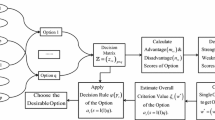Abstract
Divergence measure is an important tool for determining the amount of discrimination between two probability distributions. Since the introduction of fuzzy sets, divergence measures between two fuzzy sets have gained attention for their applications in various fields. Exponential entropy measure has some advantages over Shannon’s entropy. In this paper, we used the idea of Jensen–Shannon divergence to define a new divergence measure called ‘fuzzy Jensen-exponential divergence (FJSD)’ for measuring the discrimination/difference between two fuzzy sets. The measure is demonstrated to satisfy some very elegant properties, which shows its strength for applications in multi-criteria decision-making problems. Further, we develop a method to solve multi-criteria decision-making problems under fuzzy phenomenon by utilizing the proposed measure and demonstrate by a numerical example.
Similar content being viewed by others
References
Burbea J, Rao CR (1982) On the convexity of some divergence measures based on entropy functions. IEEE Trans Inf Theory 28(3):489–495
Endres DM, Schindelin JE (2003) A new metric for probability distributions. IEEE Trans Inf Theory 49(7):1858–1860
Kullback S (1968) Information theory and statistics. Dover Publication, New York
Kullback S, Leibler RA (1951) On information and sufficiency. Ann Math Stat 22(1):79–86
Rao C, Nayak T (1985) Cross entropy, dissimilarity measures and characterizations of quadratic entropy. IEEE Trans Inf Theory 31(5):589–593
Rènyi A (1961) On measures of entropy and information. Proc Forth Berkeley Symp Math Stat Probab 1:547–561
Sharma BD, Mittal DP (1977) New non-additive measures of relative information. J Comb Inf Syst Sci 2:122–133
Kailath T (1967) The divergence and Bhattacharyya distance measures in signal selection. IEEE Trans Commun 15(1):52–60
Lin J (1991) Divergence measure based on Shannon entropy. IEEE Trans Inf Theory 37(1):145–151
Angulo JC, Antolin J, Rosa SL, Esquivel RO (2010) Jensen-Shannon divergence in conjugated spaces: entropy excess of atomic systems and sets with respect to their constituents. Phys A Stat Mech Appl 389(4):899–907
Ghosh M, Das D, Chakraborty C, Roy AK (2010) Automated lecukocyte recognition using fuzzy divergence. Micron 41(7):840–846
Grosse I, Bernaola-Galvan P, Carpena P et al (2002) Analysis of symbolic sequences using the Jensen-Shannon divergence. Phys Rev E 65(4):041905-1–041905-16
Gómez-Lopera JF, Martínez-Aroza J, Robles-Pérez AM et al (2000) An analysis of edge detection by using the Jensen-Shannon divergence. J Math Imag Vis 13(1):35–56
He Y, Hamza AB, Krim H (2003) A generalized divergence measure for robust image registration. IEEE Trans Signal Process 51(5):1211–1220
Lopera JFG, Aroza JM, Perez AMR et al (2000) An analysis of edge detection by using the Jensen-Shannon divergence. J Math Imag Vis 13(1):35–56
Majtey AP, Borras A, Casas M (2008) Jensen-Shannon divergence as a measure of the degree of entanglement. Int J Quant Inf 6(1):715–720
Molladavoudi S, Zainuddin H, Tim CK (2012) Jensen-Shannon divergence and non-linear quantum dynamics. Phys Lett A 376(26–27):1955–1961
Neagoe M, Popescu D, Niculescu V (2014) Applications of entropic divergence measures for DNA segmentation into high variable regions of cryptosporidium spp. gp60 gene. Rom Rep Phys 66(4):1078–1087
Naghshvar M, Javidi T, Wigger M (2015) Extrinsic Jensen-Shannon divergence: applications to variable-length coding. IEEE Trans Inf Theory 61(4):2148–2164
Zadeh LA (1965) Fuzzy sets. Inf Control 8(3):338–353
Bhandari D, Pal NR (1993) Some new information measure for fuzzy sets. Inf Sci 67(3):209–228
Hooda DS (2004) On generalized measures of fuzzy entropy. Math Slovaca 54(3):315–325
Bajaj RK, Hooda DS (2010) On some new generalized measures of fuzzy information. World Acad Sci Eng Technol 4(2):657–663
Shang X, Jiang G (1997) A note on fuzzy information measures. Pattern Recogn Lett 18(5):425–432
Shannon CE (1948) A mathematical theory of communication. Bell Syst Tech J 27(3):379–423
Pal NR, Pal SK (1989) Object-background segmentation using new definitions of entropy. IEE Proc 136(4):284–295
Pal NR, Pal SK (1991) Entropy: a new definition and its applications. IEEE Trans Syst Man Cybern 5(21):1260–1270
Kvalseth TO (2000) On exponential entropies. IEEE Int Conf Syst Man Cybernet 4:2822–2826
Verma R, Sharma BD (2011) On generalized exponential fuzzy entropy. World Acad Sci Eng Technol 60:1402–1405
Fan J, Xie W (1999) Distance measures and induced fuzzy entropy. Fuzzy Sets Syst 104(2):305–314
Merigó JM, Gil-Lafuente AM, Yager RR (2015) An overview of fuzzy research with bibliometric indicators. Appl Soft Comput 27:420–433
Hardy GH, Littlewood JE, Polya G (1951) Inequalities, 2nd edn. Cambridge University Press, Cambridge
Luca AD, Termini S (1972) A definition of non-probabilistic entropy in the setting of fuzzy sets theory. Inf Control 20(4):301–312
Kaharaman C (2008) Fuzzy multi-criteria decision-making theory and applications with recent developments. Springer, New York
Verma R, Sharma BD (2011) A measure of inaccuracy between two fuzzy sets. Cybern Inf Technol 11(2):13–23
Verma R, Sharma BD (2014) A new inaccuracy measure for fuzzy sets and its application in multi-criteria decision making. Int J Intell Syst Appl 6(5):62–69
Author information
Authors and Affiliations
Corresponding author
Additional information
An erratum to this article is available at http://dx.doi.org/10.1007/s00521-016-2613-0.
Rights and permissions
About this article
Cite this article
Verma, R., Maheshwari, S. A new measure of divergence with its application to multi-criteria decision making under fuzzy environment. Neural Comput & Applic 28, 2335–2350 (2017). https://doi.org/10.1007/s00521-016-2311-y
Received:
Accepted:
Published:
Issue Date:
DOI: https://doi.org/10.1007/s00521-016-2311-y




